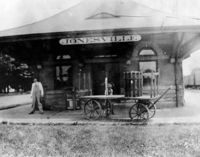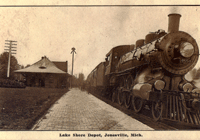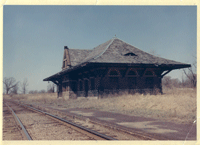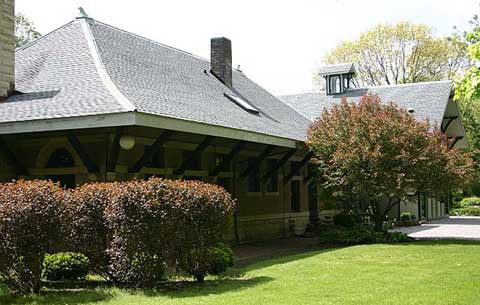History
An Ancient Highway
From mastadons to motorists
The Village of Jonesville is situated in south-central Michigan along Highway U.S. 12. Also known as “The Old Sauk Trail” and “Michigan’s Heritage Trail”, this route figures prominently in the settling of Michigan and the western territories. Indeed, it is thought to have been a pre-historic animal migration route between Lake Erie and Lake Michigan. Certainly, it was an ancient Indian trail which white pioneers later used on their march westward and, in the 1830s, it became only the second national highway funded by the United States government, connecting the forts in Detroit and Chicago. It was perhaps only natural, then, that one of the earliest west-bound railroads would also roughly travel this route.
 Today, U.S. 12 stretches from Detroit to the Pacific Ocean, terminating at Aberdeen, Washington. Along the way, this important and scenic highway passes through Chicago; Madison, WI and the beautiful Wisconsin Dells; Minneapolis-St. Paul; the plains of North and South Dakota; through Helena and Missoula, Montana and the spectacular northern Rockies; through Lewiston and Clarkston on the Snake River (on the Idaho/ Washington border), named for the famed explorers who passed through the area on their historic trek to the Pacific; and between Mt. Rainier and Mt. St. Helens in Washington State. Much of this route west of Minneapolis is featured in the cult novel, Zen and the Art of Motorcycle Maintenance.
Today, U.S. 12 stretches from Detroit to the Pacific Ocean, terminating at Aberdeen, Washington. Along the way, this important and scenic highway passes through Chicago; Madison, WI and the beautiful Wisconsin Dells; Minneapolis-St. Paul; the plains of North and South Dakota; through Helena and Missoula, Montana and the spectacular northern Rockies; through Lewiston and Clarkston on the Snake River (on the Idaho/ Washington border), named for the famed explorers who passed through the area on their historic trek to the Pacific; and between Mt. Rainier and Mt. St. Helens in Washington State. Much of this route west of Minneapolis is featured in the cult novel, Zen and the Art of Motorcycle Maintenance.
The Jonesville Depot
Once a stop on the Main Line from New York to Chicago
 The railroad first came to the area in the 1850s. The present building (which replaced a smaller wooden structure) was built in 1898 by the Lake Shore and Michigan Southern Railroad Company which, soon after, merged with the New York Central Railroad (which had long had a significant financial interest in the line). In the mid-1800s, this was a stop on the Main Line between New York and Chicago. It’s fun to imagine the famous people who probably passed through here, from presidents to poets, and from captains of industry to generals of the Grand Army.
The railroad first came to the area in the 1850s. The present building (which replaced a smaller wooden structure) was built in 1898 by the Lake Shore and Michigan Southern Railroad Company which, soon after, merged with the New York Central Railroad (which had long had a significant financial interest in the line). In the mid-1800s, this was a stop on the Main Line between New York and Chicago. It’s fun to imagine the famous people who probably passed through here, from presidents to poets, and from captains of industry to generals of the Grand Army.
By the 1870s, this route was superseded by a more direct route through northern Ohio and Indiana. Nevertheless, the Jonesville Depot remained very active until the mid-1950s when it was abandoned due to declining rail passenger traffic.
A rescued relic becomes a home
 The current owners purchased the long-neglected depot from the Penn Central Railroad Company in 1970. They proceeded over the next three decades to transform the building and 8 acres into a beautiful if unusual home taking care to preserve the architectural integrity of the depot while making the space “livable”.
The current owners purchased the long-neglected depot from the Penn Central Railroad Company in 1970. They proceeded over the next three decades to transform the building and 8 acres into a beautiful if unusual home taking care to preserve the architectural integrity of the depot while making the space “livable”.
Despite its historic appearance, the attached “carriage house” is not original to the property but was, in fact, built in 1974 as a garage and work/storage space. In 1978, the upper story of this 2,400 sq, ft. structure was developed into a rental apartment, which it remained for 25 years.

“Open For Business” once more
In 2004, faced with an “empty nest” and in anticipation of retirement, the owners decided to convert the property into a small, upscale country inn. The carriage house was gutted and remodeled to accommodate three spacious guest suites, one of which (downstairs) is barrier free. There are also two guest suites in the old station house. The 600-plus square foot garden cottage was completed in 2016.
Facilities include a commercial kitchen from which the innkeepers cater many events on site. Numerous and varied spaces, both in the carriage house and the original depot, are used for dining, weddings, and other entertaining, as are the extensive and beautifully landscaped grounds.
Freight trains still rumble past the old depot from time to time, these days on track operated by the Indiana Northeastern Railroad Company. Despite the owners’ initial worries, guests at Grayfield are delighted to witness a passing freight or, better still, an occasional century-old steam train reminiscent of the glory days of rail service.
